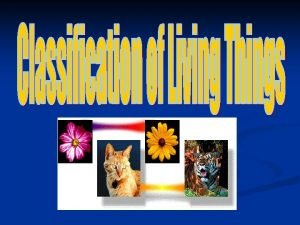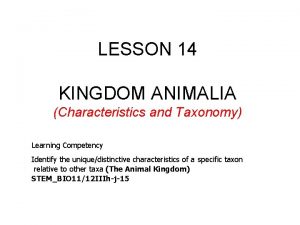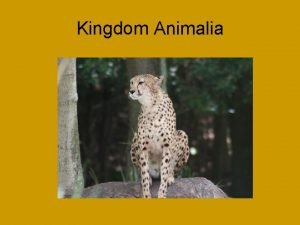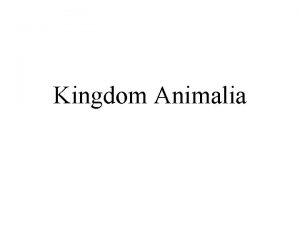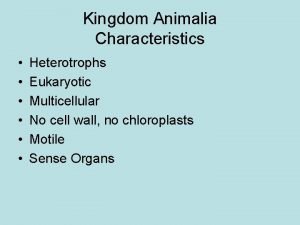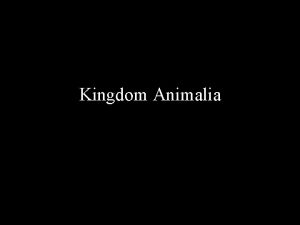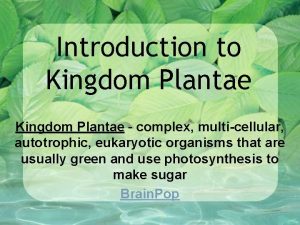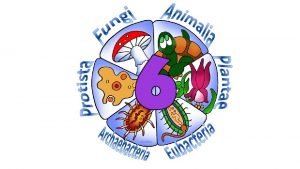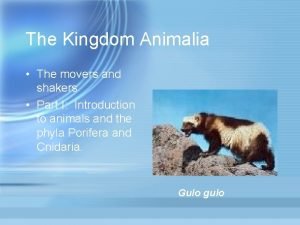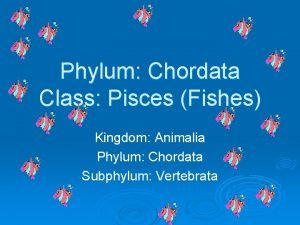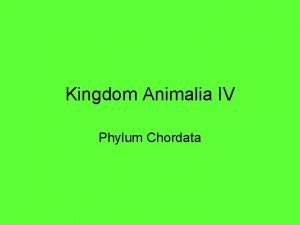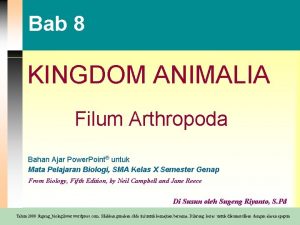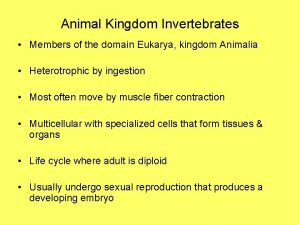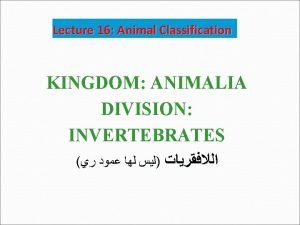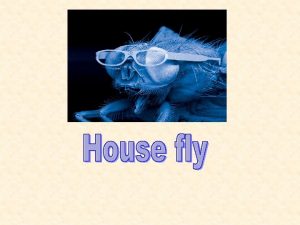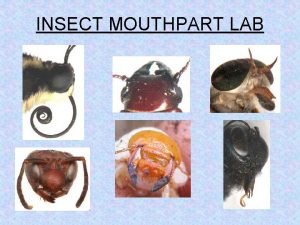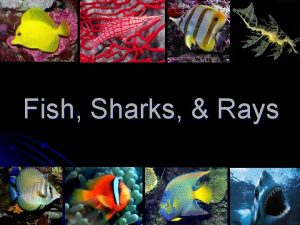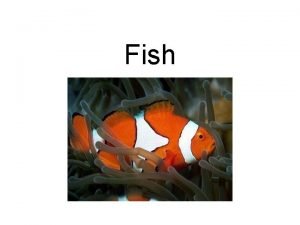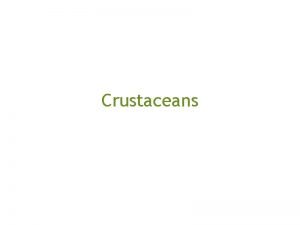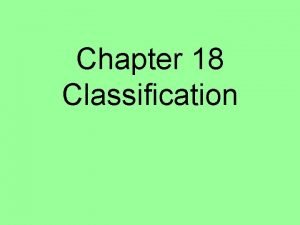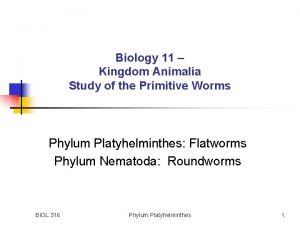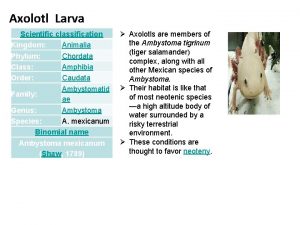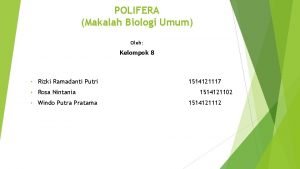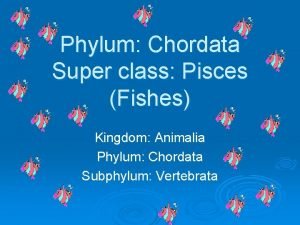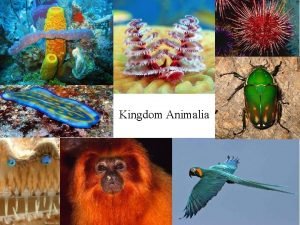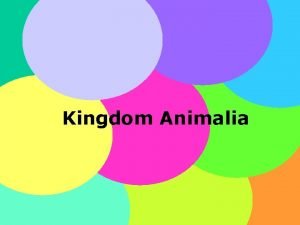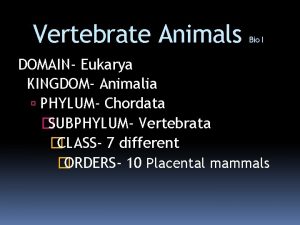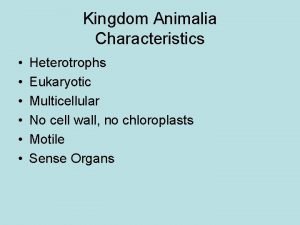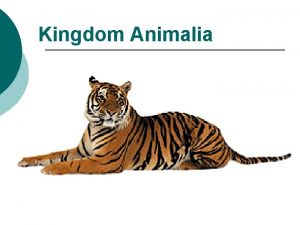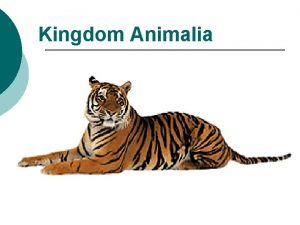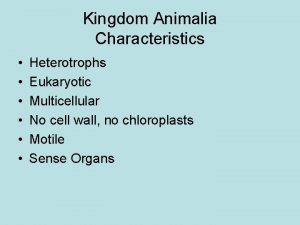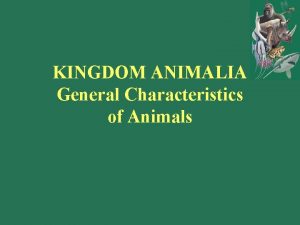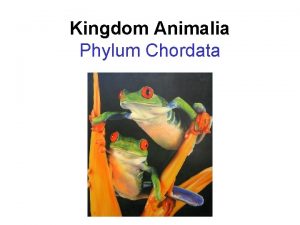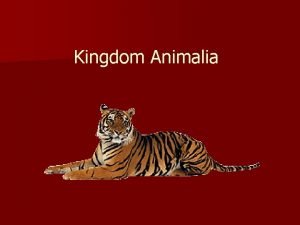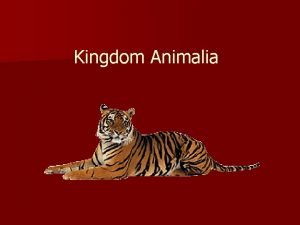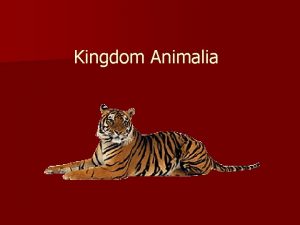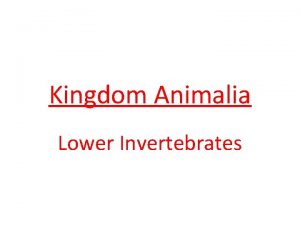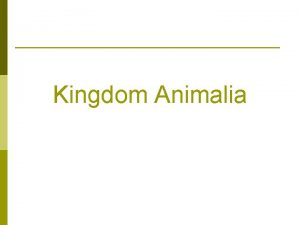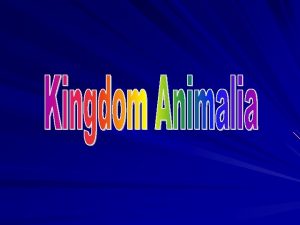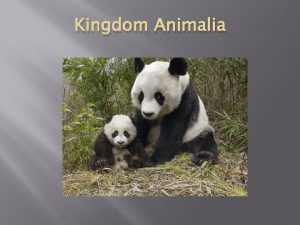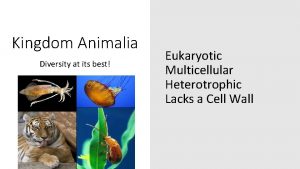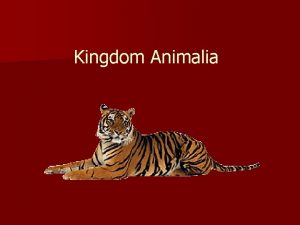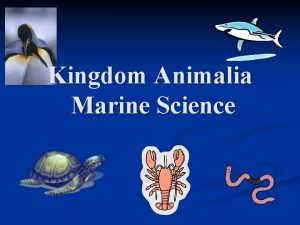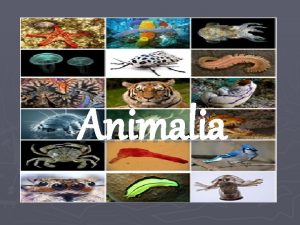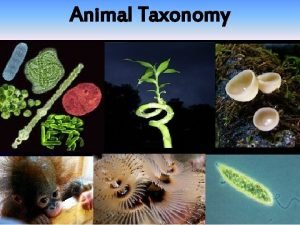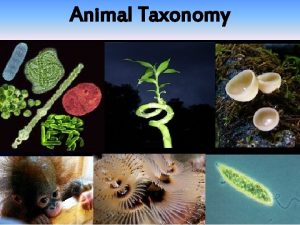Kingdom Animalia General Characteristics Eukaryotic Multicellular No cell











































- Slides: 43

Kingdom Animalia

General Characteristics • • Eukaryotic Multicellular No cell walls Move to find the following: – Food – Shelter – Protection – Mates

General Characteristics (continued) • Heterotrophs – eat other organisms for energy – Omnivore (plants & animals) – Carnivore (animals only) – Herbivore (plants only)

General Characteristics (continued) • Digest their food because food must be broken down to fit inside the cells for metabolizing

Classification – 9 major phyla • Porifera – animals have holes throughout their body (Ex: Sponges) • Cnidaria – animals with soft bodies and cnidocytes = stinging cells (Ex: jellyfish, hydra, sea anemone, coral) • Platyhelminthes – flat worms (Ex: planarians, tapeworms) • Nematoda – round worms (Ex: heartworm, trichinella, pin worms) • Mollusca – mollusks (Ex: snails, slugs, clams, oysters, octopus, squid) • Annelida – segmented worms (Ex: earthworm & leeches) • Arthropoda – insects, crustaceans, arachnids • Echinodermata – spiny skinned animals (Ex: Sea star) • Chordata – animals with a backbone = Vertebrates

Origin of Invertebrates • Between 610 – 570 MYA (millions of years ago): First eukaryotic, MULTICELLULAR organisms • Most likely flat, plate-shaped organisms with soft bodies that absorbed nutrients from their water environments (possibly lived in symbiotic relationships with photosynthetic algae) • Bilateral symmetry and possible segmentation • Very little cell specialization or body organization

The Cambrian Period • Explosion of Animals • Began 544 MYA • Evolution of shells, skeletons, and other hard outer coverings • More specialized cells, tissue and the beginnings of organ systems • Body symmetry, segmentation, some of type of skeleton, anterior & posterior ends and appendages for specific functions

Cladogram of Invertebrate Evolution Phylum Cnidaria: Cnidarians Phylum Platyhelminthes: Flatworms Phylum Nematoda: Roundworms Phylum Mollusca: Mollusks Phylum Echinodermata: Echinoderms Phylum Annelida: Annelids Phylum Arthropoda: Arthropods Radial Symmetry Phylum Porifera: Sponges Pseudocoelom Radial Symmetry Protostome Development Three Germ Layers; Bilateral Symmetry Tissues Single-celled ancestor Phylum Chordata: Chordates Multicellularity Deuterostome Development Coelom

Evolutionary Trends Specialized Cells, Tissues & Organs 1. PORIFERA & CNIDARIA: No tissues, organs nor organ systems – just specialized cells Germ Layers: Porifera (sponges) – 0 Cnidaria (jellyfish, coral, sea anemone) – 2 2. WORMS: First Appearance of Organs & Organ Systems Germ Layers: 3 Platyhelminthes (planarians & tapeworms) Nematoda (hookworm, heartworm, pinworm) Annelida (earthworm & leeches) Mollusca (snails, slugs, clams, squid, octopus) Arthropoda (insects, arachnids, centipedes, shrimp, lobster) Echinodermata (sea star, sand dollar) Chordata (vertebrates) Body Symmetry – Asymmetry: Porifera – Radial: Cnidaria & Echinodermata – Bilateral: Platyhelminthes, Nematoda, Annelida, Mollusca, Arthropoda & Chordata

Evolutionary Trends (continued) Cephalization – Concentration of nerve cells at the anterior end of the animal – Evolved with bilateral symmetry – Began with GANGLIA in WORMS – Eventually, the evolution of the BRAIN starting in MOLLUSKS and ARTHROPODS Coelom (BODY CAVITY) Formation – Evolved with the development of 3 germ layers – ACOELOMATES: no body cavity • PORIFERA • CNIDARIA • PLATYHELMINTHES (flatworms) – PSEUDOCOELOMATES: partial body cavity • NEMATODA (roundworms) – COELOMATES: true body cavity • • • ANNELIDA MOLLUSCA ARTHROPODA ECHINODERMATA CHORDATA Embryology – Protostomes (mouth before anus): SPONGES to ARTHROPODS – Deuterostomes (anus before mouth): ECHINODERMS & CHORDATES

Body Plans • Asymmetry = no definite shape (sponge) • Radial Symmetry = circle body plan with a central point (sea star, jellyfish, sand dollar, hydra) • Bilateral Symmetry = 2 sides of the body are arranged in the same way; the 2 sides of the body are almost mirror images of each other (most animals have this type of symmetry)

Body Directions • Dorsal side = backside of animal (darker) • Ventral side = belly-side of animal • Lateral = left and right side of the animal; away from the midline • Medial- Toward the midline • Anterior end = head end (cephalization – concentration of nerve cells at the anterior end of the animal which results in the formation of a true brain) • Posterior end = tail end

Early Development of Animals • Fertilized egg = Zygote • Zygote Embryo • Embryo continues to divide to become a BLASTULA (hollow ball of cells) • The Blastula folds creating an opening called a BLASTOPORE = called GASTRULATION • Blastopore leads to a tube which will become the following: – Protostomes: mouth- ex. earthworm – Deuterostomes: anus- ex. echinoderms

Blastulation & Gastrulation

Germ Layers • Endoderm (innermost germ layer): gives rise to the lining of the digestive & respiratory tract • Mesoderm (middle germ layer): gives rise to muscles, circulatory, reproductive and excretory systems • Ectoderm (outermost germ layer): gives rise to sensory organs, nerves, integumentary system (skin, hair, nails, etc. )

Germ Layers

Porifera • • • Hollow tube body plan: ACOELOMATE – no coelom Contains pores (holes) throughout body No tissue, organs and organ systems Live in water Asymmetry As adults sponges are SESSILE – attach to one place & do not move for the rest of its life Filter feeders Reproduce asexually and sexually – HERMAPHRODITES (have both male & female reproductive organs) – external fertilization Water goes into pores and out the OSCULUM Ectoderm (outside) can be made of soft, flexible material called spongin or hard, spiky material called spicules

Porifera Chart • • No Germ Layers No cephalization Acoelomate Circulatory: Diffusion Digestive: Filter Feeders Nervous System: None; Produces Toxins Excretory System- Diffusion Reproductive: Sexually/Internal Fertilization or Asexually via budding and gemmules • Respiratory System: Diffusion • Movement: Sessile as Adults

Cnidaria • Soft bodies • Tentacles with cnidocytes = stinging cells • Inside each cnidocyte is a nematocyst = coiled barbed stinger with poison • Cnidocytes are triggered by touch • Used to paralyze & capture prey • Radial symmetry • Contain tissue • Acoelomates • Digestive cavity that breaks down food using enzymes • Mouth • No circulatory/respiratory systems • Simple nervous system called Nerve Net or Nerve Ring • 2 Body types – Medusa (moves) & Polyp (sessile) • Sexually reproduce – hermaphrodites – external fertilization

Classes of Cnidaria • Class Hydrozoa – hydra, man of war • Class Scyphozoa – jellyfish • Class Anthozoa – sea anemone & coral

Cnidocyte Being Triggered

Cnidarians Chart • • • Germ layers: 2 Symmetry: Radial No Cephalization Acoelomate Circulatory: Diffusion Digestive/ Feeding: 1 opening with gastrovascular cavity Nervous: specialized cells- simple system called nerve net Excretory: Diffusion Reproductive: sexually/ separate sexes/external fertilizationasexually via budding • Respiratory: Diffusion • Movement: Medusa (moves with current) or Polyp (sessile)

Worms • Invertebrates with soft bodies • Bilateral symmetry • Tissue, organs, organ systems • 3 types: – Flat – Round – Segmented

Platyhelminthes • • • Platy = flat, helminthe = worm Free-living = planarian Parasites = tapeworm Has the first primitive excretory system called FLAME BULB CELLS = removal of ammonia (urea = higher forms of animals) No circulatory/respiratory system – get oxygen & nutrients thru osmosis & diffusion Digestive system = intestines for digesting food Have one opening that serves as both mouth and anus Sexually reproduction – hermaphrodites – internal fertilization Can regenerate

Examples of Flatworms Tapeworms

Platyhelminthes Chart • • Germ layers: 3 Symmetry: Bilateral Cephalization Present Acoelomate Circulatory: Diffusion- No internal transport system Digestive/ Feeding: 1 opening with digestive cavity and pharynx Nervous: ganglia groups of nerve cells and eyespots Excretory: Flame cells that remove excess water and metabolize waste (ammonia) • Reproductive: sexually/hermaphrodites –asexually via fission • Respiratory: Diffusion • Movement: Turbellians use cilia to move while parasitic worms rely on the host's circulation

Nematoda • • • Round worms Largest phylum of worms (in number) Some free-living, some parasitic Live in soil, fresh & salt water, animals Has a tube within a tube body plan Has a complete digestive tract with a separate mouth and anus (pseudocoelom) • No circulatory/respiratory system • Sexual reproduction – internal fertilization

Examples • Hookworm • Ascaris (pinworm-live in the intestine of its hosts) • Trichinella (found in the muscles of pigs) • Filarial Worms (live in blood & lymph vessels of birds and mammals) • Heartworm

PARASITIC ROUNDWORMS

Nematoda Chart • • • Germ layers: 3 Symmetry: Bilateral Cephalization Present Pseudocoelomate Circulatory: Diffusion- No internal transport system Digestive/ Feeding: 2 openings- complete Nervous: simple nervous system and several ganglia Excretory: diffusion Reproductive: sexually/individual sexes/internal fertilization Respiratory: Diffusion Movement: undulatory; nematodes are poor swimmers and usually require contact with a substrate to move.

Mollusca • Soft-bodied invertebrates that usually have shells (valves) • Live on land, fresh & salt water • Bilateral symmetry • Has a true coelom = cavity where all the organs are held • Common body parts: – Mantle = thin tissue that covers soft body – Mantle cavity = where the gills are located – Visceral mass = coelom (gut) where all the organs are held – Foot = strong muscle used for movement • 1 st group of animals to have a circulatory & respiratory system (heart & gills) • 2 types of circulatory systems: CLOSED (vessels) & OPEN (no vessels)

Classes of Mollusks • Univalves or Gastropods (snails, slugs) • Bivalves (clams, oysters, mussels, scallops = adductor muscles of clams) • Cephalopods (octopus, squid) – complex nervous system – centralized with a true brain, closed circulatory system, stream-lined to move quickly, very smart

Mollusca Chart • • • Germ layers: 3 Symmetry: Bilateral Cephalization Present True Coelom Circulatory: Slow Moving- Open and Fast Moving- Closed Digestive/ Feeding: herbivores, omnivores, filter-feeders, detritivores, parasites/ radula tongue with teeth Nervous: bivalves: simple nervous system (eyespots) and octopi well developed brains and intelligent Excretory: nephridia remove ammonia Reproductive: sexually/internal or external fertilization Respiratory: Gills (aquatic) and Mantle cavity (terrestrial) Movement: muscular foot that it uses for movement or propulsion by pressing water from their pallial cavity, squids move backwards through the water like a rocket

Complex Invertebrates Phylum Annelida, Arthropoda & Phylum Echinodermata

Annelida • • Segmented worms Bilateral symmetry Tube shaped bodies Has a true coelom Ex: earthworms & leeches Complete digestive system No respiratory system (oxygen diffuses thru skin) Nervous system – pair of ganglia and a ventral nerve cord • Circulatory system – 5 aortic arches that serve as the heart and a dorsal & ventral blood vessel (closed) • Excretory system • Sexually reproduces – hermaphrodites – external fertilization

Annelida Chart • • • Germ layers: 3 Symmetry: Bilateral Cephalization Present True Coelom Circulatory: Closed/Dorsal and Ventral Blood Vessel Digestive/ Feeding: 2 openings- complete order: mouth, pharynx, esophagus, crop, gizzard, intestine and anus Nervous: well developed, brain and several nerve cords, 2 or more sets of eyes, sensory tentacles, statocysts Excretory: nephridia Reproductive: sexually/individual sexes/external fertilization/ clitellum Respiratory: Gills (aquatic) and Diffusion across skin (terrestrial) Movement: various muscle groups and simple appendages. They use setae and parapodia for movement

Arthropods • • Arthro = joint; Pod = foot All appendages are jointed Largest phylum in the animal kingdom Usually has 3 body sections: – Head – Thorax – Abdomen

Arthropoda Chart • • • Germ layers: 3 Symmetry: Bilateral Cephalization Present True Coelom Circulatory: Open System Digestive/ Feeding: herbivore, carnivore and omnivore/mouthparts vary Nervous: well developed, brain and sense organs: eyes, taste receptors Excretory: Malpighian Tubules/ Diffusion in aquatic arthropods Reproductive: sexually/individual sexes/internal (terrestrial) and internal or external (aquatic) Respiratory: Tracheal Tubes- Grasshoppers and Book Lungs- Spiders Movement: Jointed Appendages

Major Characteristics (continued) • Has an exoskeleton made of chitin which is shed when the arthropod grows – process is called MOLTING • Has a coelom – gut that holds all the organs • Have ALL the body systems • 5 classes – Arachnids – Centipedes – Millipedes – Crustaceans – Insects

Class Insecta • • • Able to fly Have antennae Compound eyes (multiple lenses) Open circulatory system Blood does not carry oxygen = blood is clear • Respiratory system = spiracles & book lungs • Goes through Metamorphosis = change in the body from the young to adult; triggered by hormones

Metamorphosis • Complete = 4 stages: Egg, Larva, Pupa, Adult • Incomplete = 3 stages: Egg, Nymph, Adult • Why go through this life cycle? ! – Adults and young have different homes, food sources and predators, therefore, they will not compete increasing their chance of survival

Echinoderms • Echino = spiny; derm = skin • Embryos develop like the embryo of vertebrates = DEUTEROSTOMES • Internal skeleton (endoskeleton) made of calcium plates • Water vascular system with tube feet that carry out its body functions

Echinodermata Chart • • • Germ layers: 3 Symmetry: Radial No Cephalization Deuterostome- Only Invertebrate Circulatory: Water Vascular System Digestive/ Feeding: carnivores tube feet Nervous: no head/not well-developed/ nerve rings and radial nerves Excretory: Feces released through anus and ammonia through tube feet or skin gills Reproductive: sexually/individual sexes/external Respiratory: Tube feet/ water vascular system and skin gills Movement: The water vascular system of echinoderms is responsible for their movement and ability to clean to surfaces for long periods of time
 Kingdom protista prokaryotic or eukaryotic
Kingdom protista prokaryotic or eukaryotic Kingdom animalia cell structure
Kingdom animalia cell structure Larvacea
Larvacea Characteristics of animalia kingdom
Characteristics of animalia kingdom Characteristics of animalia kingdom
Characteristics of animalia kingdom Old kingdom middle kingdom new kingdom
Old kingdom middle kingdom new kingdom Nnn ruled
Nnn ruled Youtube egypt
Youtube egypt Old kingdom middle kingdom new kingdom
Old kingdom middle kingdom new kingdom Prokaryotic vs eukaryotic cell
Prokaryotic vs eukaryotic cell Prokaryotic
Prokaryotic Prokaryotic cell and eukaryotic cell
Prokaryotic cell and eukaryotic cell Carbohydrate side chain
Carbohydrate side chain Prokaryotic cell vs eukaryotic cell
Prokaryotic cell vs eukaryotic cell Animalia multicellular
Animalia multicellular Automorphic traits
Automorphic traits Multicellular eukaryotic autotrophic organisms
Multicellular eukaryotic autotrophic organisms Eukaryotic unicellular or multicellular
Eukaryotic unicellular or multicellular Nine phyla of kingdom animalia
Nine phyla of kingdom animalia Kingdom animalia cladogram
Kingdom animalia cladogram Fish teeth pisces
Fish teeth pisces Monera, protista, fungi, plantae animalia
Monera, protista, fungi, plantae animalia What are chordata
What are chordata Arthropoda
Arthropoda Which are all members of the domain eukarya
Which are all members of the domain eukarya Animalia division
Animalia division Phylum chordata mammalia
Phylum chordata mammalia Diptera
Diptera Kingdom animalia domain
Kingdom animalia domain Are insects in kingdom animalia
Are insects in kingdom animalia Animalia kingdom
Animalia kingdom Kingdom animalia fish
Kingdom animalia fish To which sub phylum
To which sub phylum Kingdom animalia phylum arthropoda
Kingdom animalia phylum arthropoda Kingdom animalia contains 350 000 species of what
Kingdom animalia contains 350 000 species of what Characteristics of platyhelminthes
Characteristics of platyhelminthes Larva classification
Larva classification Animal kingdom phylogeny
Animal kingdom phylogeny Polifera
Polifera Cnidaria digestive system
Cnidaria digestive system Pisces kingdom animalia
Pisces kingdom animalia Monogenea class
Monogenea class Ciri animalia
Ciri animalia All vertebrate animals are in domain
All vertebrate animals are in domain

